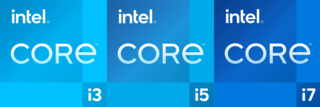Related Research Articles

Advanced Micro Devices, Inc. (AMD) is an American multinational semiconductor company based in Santa Clara, California, that develops computer processors and related technologies for business and consumer markets. While it initially manufactured its own processors, the company later outsourced its manufacturing, a practice known as going fabless, after GlobalFoundries was spun off in 2009. AMD's main products include microprocessors, motherboard chipsets, embedded processors and graphics processors for servers, workstations, personal computers and embedded system applications.

The AMD Accelerated Processing Unit (APU), formerly known as Fusion, is the marketing term for a series of 64-bit microprocessors from Advanced Micro Devices (AMD), designed to act as a central processing unit (CPU) and graphics processing unit (GPU) on a single die. APUs are general purpose processors that feature integrated graphics processors (IGPs).
The 14 nm process refers to the MOSFET technology node that is the successor to the 22 nm node. The 14 nm was so named by the International Technology Roadmap for Semiconductors (ITRS). Until about 2011, the node following 22 nm was expected to be 16 nm. All 14 nm nodes use FinFET technology, a type of multi-gate MOSFET technology that is a non-planar evolution of planar silicon CMOS technology.
In computing the average CPU power (ACP) is the power consumption of central processing units, especially server processors, under "average" daily usage as defined by Advanced Micro Devices (AMD) for use in its line of processors based on the K10 microarchitecture. Intel's thermal design power (TDP), used for Pentium and Core 2 processors, measures the energy consumption under high workload; it is numerically somewhat higher than the "average" ACP rating of the same processor.

Intel Core are streamlined midrange consumer, workstation and enthusiast computers central processing units (CPU) marketed by Intel Corporation. These processors displaced the existing mid- to high-end Pentium processors at the time of their introduction, moving the Pentium to the entry level, and bumping the Celeron series of processors to the low end. Identical or more capable versions of Core processors are also sold as Xeon processors for the server and workstation markets.
In semiconductor manufacturing, the International Technology Roadmap for Semiconductors defines the 7 nm process as the MOSFET technology node following the 10 nm node. It is based on FinFET technology, a type of multi-gate MOSFET technology.

AMD FX was a series of high-end AMD microprocessors for personal computers debuted in 2011, claimed as AMD's first native 8-core desktop processor. The line was introduced with the Bulldozer microarchitecture at launch, and was then succeeded by its derivative Piledriver in 2012.
Cannon Lake is Intel's codename for the 10-nanometer die shrink of the Kaby Lake microarchitecture. As a die shrink, Cannon Lake is a new process in Intel's "Process-Architecture-Optimization" execution plan as the next step in semiconductor fabrication. Cannon Lake CPUs are the first mainstream CPUs to include the AVX-512 instruction set.
AMD Steamroller Family 15h is a microarchitecture developed by AMD for AMD APUs, which succeeded Piledriver in the beginning of 2014 as the third-generation Bulldozer-based microarchitecture. Steamroller APUs continue to use two-core modules as their predecessors, while aiming at achieving greater levels of parallelism.
Zen is the codename for a family of computer processor microarchitectures from AMD, first launched in February 2017 with the first generation of its Ryzen CPUs.

Zen is the codename for the first iteration in a family of computer processor microarchitectures of the same name from AMD. It was first used with their Ryzen series of CPUs in February 2017. The first Zen-based preview system was demonstrated at E3 2016, and first substantially detailed at an event hosted a block away from the Intel Developer Forum 2016. The first Zen-based CPUs codenamed "Summit Ridge" reached the market in early March 2017, Zen-derived Epyc server processors launched in June 2017 and Zen-based APUs arrived in November 2017.

Zen 2 is the codename for a computer processor microarchitecture by AMD. It is the successor of AMD's Zen and Zen+ microarchitectures, and is fabricated on the 7 nanometer MOSFET node from TSMC. The microarchitecture powers the third generation of Ryzen processors, known as Ryzen 3000 for the mainstream desktop chips, Ryzen 4000U and Ryzen 5000U for mobile applications, as Threadripper 3000 for high-end desktop systems, and as Ryzen 4000G for accelerated processing units (APUs). The Ryzen 3000 series CPUs were released on 7 July 2019, while the Zen 2-based Epyc server CPUs were released on 7 August 2019. An additional chip, the Ryzen 9 3950X, was released in November 2019.
Ice Lake is Intel's codename for the 10th generation Intel Core mobile processors based on the new Sunny Cove Core microarchitecture. Ice Lake represents an Architecture step in Intel's Process-Architecture-Optimization model. Ice Lake CPUs are sold together with the 14 nm Comet Lake CPUs as Intel's "10th Generation Core" product family.
Ryzen is a brand of x86-64 microprocessors designed and marketed by Advanced Micro Devices (AMD) for desktop, mobile, server, and embedded platforms based on the Zen microarchitecture. It consists of central processing units (CPUs) marketed for mainstream, enthusiast, server, and workstation segments and accelerated processing units (APUs) marketed for mainstream and entry-level segments and embedded systems applications.

EPYC is a brand of x86-64 microprocessors designed and sold by AMD, based on the company's Zen microarchitecture. Introduced in June 2017, they are specifically targeted for the server and embedded system markets. Epyc processors share the same microarchitecture as their regular desktop-grade counterparts, but have enterprise-grade features such as higher core counts, more PCI Express lanes, support for larger amounts of RAM, and larger cache memory. They also support multi-chip and dual-socket system configurations by using Infinity Fabric interchip interconnect.
Rocket Lake is a codename for Intel’s desktop x86 chip family to be released on March 30, 2021. It is based on the new Cypress Cove microarchitecture, a variant of Sunny Cove backported to the older 14nm process. The chips will be marketed as "Intel 11th generation Core". The Rocket Lake cores contain significantly more transistors than current Skylake-derived Comet Lake cores.
Tremont is a microarchitecture for low-power Atom, Celeron and Pentium Silver branded processors used in systems on a chip (SoCs) made by Intel, it is the successor to Goldmont Plus. Intel officially launched Elkhart Lake platform with 10nm Tremont core on September 23, 2020. Intel officially launched Jasper Lake platform with 10nm Tremont core on January 11, 2021.
Alder Lake is Intel's codename for the 12th and upcoming generation of Intel Core processors based on a hybrid architecture utilizing Golden Cove high-performance cores and Gracemont power-saving cores. Intel expects to launch Alder Lake in the second half of 2021. It is expected to use the 10 nm Enhanced SuperFin (ESF) process and a new LGA 1700 socket with DDR5 support.
Gracemont is an upcoming microarchitecture for low-power processors used in systems on a chip (SoCs) made by Intel, and is the successor to Tremont. Like its predecessor, it will also be implemented as low-power cores in a hybrid design of the upcoming Alder Lake processors.
References
- ↑ July 2020, Paul Alcorn 23. "Intel's 7nm is Broken, Company Announces Delay Until 2022, 2023". Tom's Hardware. Retrieved 2020-08-27.
- ↑ Apr 28th, btarunr; Discuss, 2020 03:46. "Intel's First 7nm Client Microarchitecture is "Meteor Lake"". TechPowerUp.CS1 maint: numeric names: authors list (link)
- ↑ "Intel Meteor Lake: first 7nm microarchitecture likely to overlap AMD's 5nm products". OptoCrypto. April 28, 2020.
- ↑ Dec 12th, btarunr; Discuss, 2020 03:46. "Intel Unveils a Clean-slate CPU Core Architecture Codenamed "Sunny Cove"". TechPowerUp.CS1 maint: numeric names: authors list (link)
- ↑ Mujtaba, Hassan (2020-09-14). "Intel Confirms Tiger Lake 10nm CPUs With 8 Cores & 16 Threads Launching Next Year". Wccftech. Retrieved 2020-12-04.